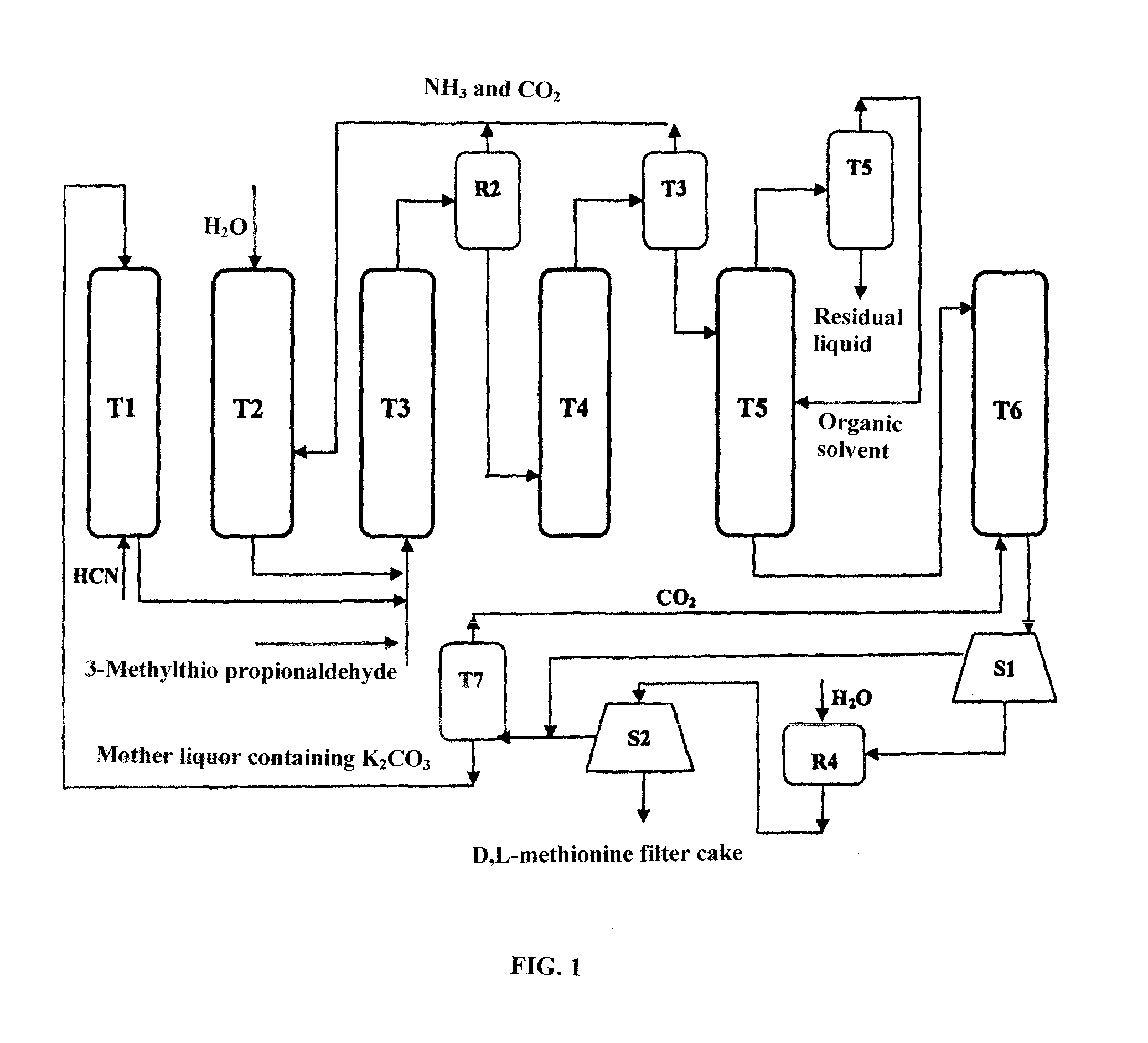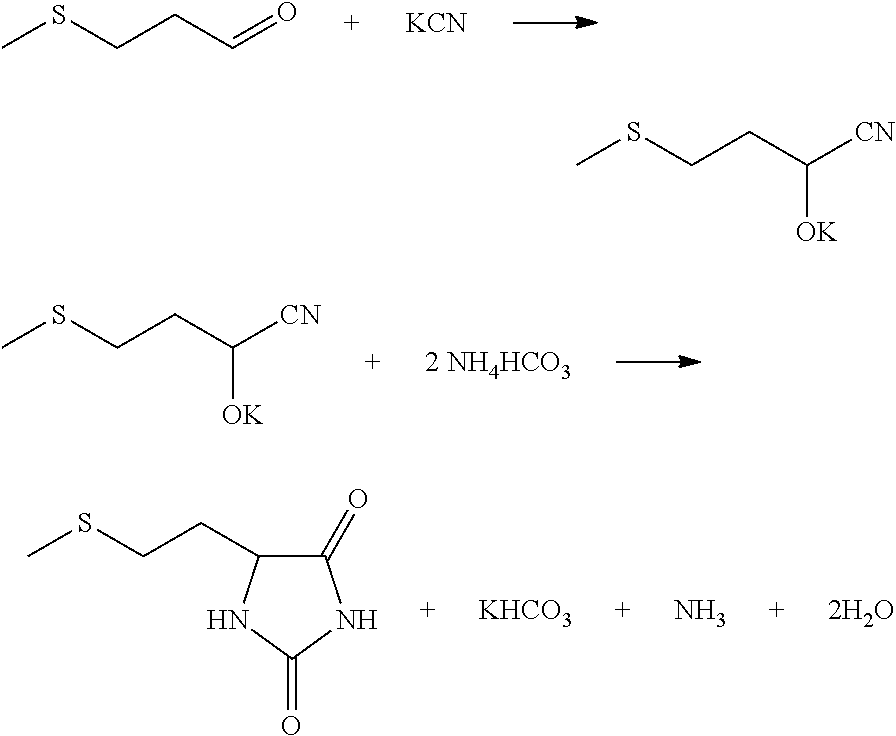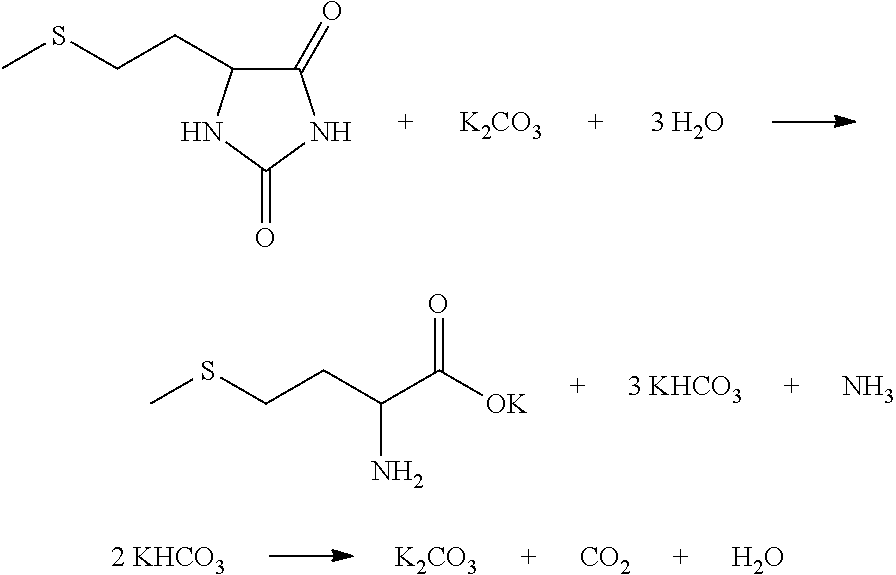Clean method for preparing d,l-methionine
a technology of l-methionine and d, which is applied in the field of compound synthesis, can solve the problems of large quantity of wastewater, inability to recycle solutions, and significant increase in the product cost of d,l-methionine, and achieve the effect of convenient operation
- Summary
- Abstract
- Description
- Claims
- Application Information
AI Technical Summary
Benefits of technology
Problems solved by technology
Method used
Image
Examples
embodiment 1
[0045]A metering liquid delivery pump was used to deliver treated crystallization mother solution (10% K2CO3 solution was used at the initial start-up) to the HCN absorption column T1 at the flow rate of 700 Kg / h. Meanwhile, 5.4 Kg / h HCN gas was delivered to the HCN absorption column for preparation of a KCN solution in the HCN absorption column T1, and a liquid delivery pump was used to deliver the KCN solution to the first tubular reactor R1. A liquid delivery pump was used to deliver ammonium bicarbonate absorbing ammonia gas and carbon dioxide in the CO2NH3 absorption column T2 to the first tubular reactor R1 (16% ammonia bicarbonate solution was used at the initial start-up) at the velocity of 200 Kg / h, and a liquid delivery pump was used to deliver 3-methylthio propionaldehyde to the first tubular reactor R1 at the velocity of 20.8 Kg / h simultaneously. The reaction fluid was stayed for 7 minutes respectively at the temperature of 50° C. and 100° C., and stayed for another 1 mi...
embodiment 2
[0048]A metering liquid delivery pump was used to deliver treated crystallization mother solution (10% K2CO3 solution was used at the initial start-up) to the T1 HCN absorption column at the flow rate of 552 Kg / h. Meanwhile, HCN gas was delivered to the HCN absorption column at 5.94 Kg / h for preparation of the KCN solution in the HCN absorption column T1, and a liquid delivery pump was used to deliver the KCN solution to the first tubular reactor R1. A liquid delivery pump was used to deliver ammonium bicarbonate absorbing ammonia gas and carbon dioxide in the CO2NH3 absorption column T2 to the first tubular reactor R1 (16% ammonia bicarbonate solution was used at the initial start-up) at the velocity of 250 Kg / h, and a liquid delivery pump was used to deliver 3-methylthio propionaldehyde to the first tubular reactor R1 at the velocity of 20.8 Kg / h simultaneously. The reaction fluid stayed for 3 minutes respectively at the temperature of 60° C. and 120° C., and stayed for another 1 ...
embodiment 3
[0051]A metering liquid delivery pump was used to deliver treated crystallization mother solution (10° K2CO3 solution was used at the initial start-up) to the HCN absorption column T1 at the flow rate of 828 Kg / h. Meanwhile, 5.67 Kg / h HCN gas was delivered to the HCN absorption column for preparation of the KCN solution in the HCN absorption column T1, and a liquid delivery pump was used to deliver the KCN solution to the first tubular reactor R1. A liquid delivery pump was used to deliver ammonium bicarbonate absorbing ammonia gas and carbon dioxide in CO2NH3 absorption column T2 to the first tubular reactor R1 (16% ammonia bicarbonate solution was used at the initial start-up) at the velocity of 300 Kg / h, and a liquid delivery pump was used to deliver 3-methylthio propionaldehyde to the first tubular reactor R1 at the velocity of 20.8 Kg / h simultaneously. The reaction fluid stayed for 1 minutes and 2 minutes respectively at the temperature of 90° C. and 120° C., and stayed for ano...
PUM
| Property | Measurement | Unit |
|---|---|---|
| mole ratio | aaaaa | aaaaa |
| temperature | aaaaa | aaaaa |
| temperature | aaaaa | aaaaa |
Abstract
Description
Claims
Application Information
 Login to View More
Login to View More - R&D
- Intellectual Property
- Life Sciences
- Materials
- Tech Scout
- Unparalleled Data Quality
- Higher Quality Content
- 60% Fewer Hallucinations
Browse by: Latest US Patents, China's latest patents, Technical Efficacy Thesaurus, Application Domain, Technology Topic, Popular Technical Reports.
© 2025 PatSnap. All rights reserved.Legal|Privacy policy|Modern Slavery Act Transparency Statement|Sitemap|About US| Contact US: help@patsnap.com



